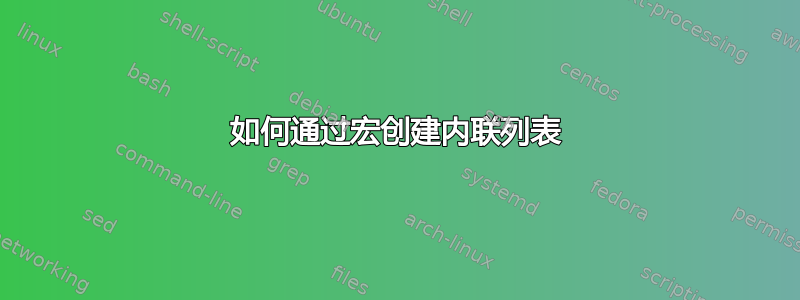
我想创建一个产生内联列表的宏。我可以轻松使用enumerate*以下代码轻松完成此操作:这enumitem,但是当我尝试将其包装在宏中时,我得到:
Extra }, or forgotten \endgroup. \item ...ctor \relax \fi }\color@endgroup \egroup \enit@outeritem
代码:
\documentclass{article}
\usepackage[inline]{enumitem}
\usepackage{pgffor}
\newlist{MyHChoices}{enumerate*}{2}
\setlist*[MyHChoices]{label=\Alph*., itemjoin={\hspace*{2.0em}}}
\newcommand*{\InlineList}[1]{%
\MyHChoices
\foreach \Choice in {#1} {%
\item \Choice
}%
\endMyHChoices
}%
\begin{document}
\begin{MyHChoices}
\item One
\item Two
\item Three
\end{MyHChoices}
%\InlineList{One, Two, Three}% ???
\end{document}
答案1
Token 注册方法
问题是列表环境不太令人满意,如果\item放在一个组里面,
\foreach那么pgffor将主体放在组里面。
以下文件使用令牌寄存器来收集环境主体。\Choice需要扩展一次。
\documentclass{article}
\usepackage[inline]{enumitem}
\usepackage{pgffor}
\newlist{MyHChoices}{enumerate*}{2}
\setlist*[MyHChoices]{label=\Alph*., itemjoin={\hspace*{2.0em}}}
\newtoks\gInlineToks
\newcommand*{\InlineList}[1]{%
\global\gInlineToks{}%
\foreach \Choice in {#1} {%
\global\gInlineToks\expandafter{%
\the\expandafter\gInlineToks
\expandafter\item\Choice
}%
}%
\begin{MyHChoices}\the\gInlineToks\end{MyHChoices}%
}%
\begin{document}
\begin{MyHChoices}
\item One
\item Two
\item Three
\end{MyHChoices}
\InlineList{One, Two, Three}
\end{document}
包裹kvsetkeys
另一种方法是pgffor:
\documentclass{article}
\usepackage[inline]{enumitem}
\usepackage{kvsetkeys}
\newlist{MyHChoices}{enumerate*}{2}
\setlist*[MyHChoices]{label=\Alph*., itemjoin={\hspace*{2.0em}}}
\makeatletter
\newcommand*{\InlineList}[1]{%
\begin{MyHChoices}%
\comma@parse{#1}\InlineListItem
\end{MyHChoices}%
}
\newcommand*{\InlineListItem}[1]{%
\item #1%
}
\makeatother
\begin{document}
\begin{MyHChoices}
\item One
\item Two
\item Three
\end{MyHChoices}
\InlineList{One, Two, Three}
\end{document}
答案2
您可以尝试这个,它看起来比 Heiko 的要短:
\documentclass{article}
\usepackage[inline]{enumitem}
\usepackage{xparse}
\newlist{MyHChoices}{enumerate*}{2}
\setlist*[MyHChoices]{label=\Alph*., itemjoin={\hspace*{2.0em}}}
\ExplSyntaxOn
\NewDocumentCommand{\InlineList}{ m }
{
\begin{MyHChoices}
\clist_map_inline:nn { #1 } { \item ##1 }
\end{MyHChoices}
}
\ExplSyntaxOff
\begin{document}
\begin{MyHChoices}
\item One
\item Two
\item Three
\end{MyHChoices}
\InlineList{One, Two, Three}
\end{document}
如果您计划使用除逗号以外的其他分隔符,则通常的“拆分并按顺序存储”策略非常容易遵循:
\ExplSyntaxOn
\NewDocumentCommand{\InlineList}{ O{,} m }
{
\begin{MyHChoices}
\peter_process_hchoices:nn { #1 } { #2 }
\end{MyHChoices}
}
\seq_new:N \l__peter_hchoices_seq
\cs_new_protected:Npn \peter_process_hchoices:nn #1 #2
{
\seq_set_split:Nnn \l__peter_hchoices_seq { #1 } { #2 }
\seq_map_inline:Nn \l__peter_hchoices_seq { \item ##1 }
}
\ExplSyntaxOff
使用此块代替前一个块,您可以输入列表作为
\InlineList{One, Two, Three}
\InlineList[;]{One; Two; Three}
\InlineList[/]{One / Two/ Three}
并得到相同的结果。


